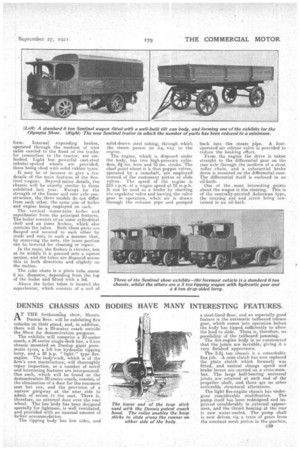SENTINEL STEAMERS FOR LOADS OF FROM 4 TO 6 TONS.
Page 18

Page 19

If you've noticed an error in this article please click here to report it so we can fix it.
ONE of the best known and most widely used under-type steam wagons :on the British ;'market is the Sentinel, which is made in several sizes to suit the requirements of all who desire to transport loads of from four to six tons.
The models for the Show will comprise one of each type, i.e., a 4 ton standard wagon with, drop-sided lorry body, a loading space of 13 ft. by 6 ft., and a wheelbase of 9 ft. 9 ins. A 5 'ton endtipping wagon, with the Sentinel patent hydraulic tipping gear, in which the water pressure is obtained by the use of a special injector similar to that utilized
028
for the boiler. The capacity of the body on this vehicle is 196 cubic. ft. The third exhibit is a 6 ton standard chassis, with a wheelbase of 10 ft. q ins. It is interesting to note that the -taming radius of this heavy vehicle is 25 ft., which is surprisingly small for such a machine.
More and more attention is being Paid to the question of utilizing trailers in order to make economical use of power units, and the new Sentinel trailer, which will be shown at Olympia for the first time, will certainly do much to popularize this procedure. It is very strongly and neatly constructed, with a pressed steel frame, and the cross structures forming the turntable. and rear carriage, instead of beingSheavily and clumsily built from channel steel, are now made from light but strong pressings.
The fore carriage and the rear carriage are exactly the same in their construction, but, of course, only the fore carriage is pivoted, the rear carriage being firmly bolted into position. If necessary, the fore carriage and rear carriage can be changed over without any difficulty.
The side stanchions holding the body, are all of exceptional strength, combined with light weight; they are, as usual, fitted into sockets attached to the plat
form. Internal expanding brakes, operated through the medium of wire cable carried to the front of the trailer for connection to the tractor, are embodied. Light but powerful cast-steel tubular-spoked wheels are provided, these being shod with solid rubber tyres.
It may be of interest to give a few details of the main features of the Sentinel wagons. Beyond minor details, the chassis will be exactly ,similar to those exhibited last, year. Except for the strength of the frame arid rear axle CCM
• struction, the three models do not diffee from each other, the same size of boiler and -engine being employed on each.
The vertical water-tube boiler arid superheater form the principal features. The boiler consists of an outer cylindrical shell and all inner firebox, which also contains the tubes, Both these parts are flanged and secured to each other by studs and nuts in such a Manner that, by removing the nuts, the innerportion can be lowered for cleaning or repair.'
In the main, the firebox is circular, but at its middle it is pressed into a square section, and the tubes are disposed across this in both directions and slightly on the incline. .
The coke chute is a plain tube about 6 ins, diameter, depending from the top Of the boiler and fitted with a lid.
Above the boiler tubes is located the superheater, which consists of a coil of solid-drawn steel tubing, through which the steam passes on its, way to the engine.
The engine, which is disposed under the body, has two high-pressure cylinders, 64 ins, bore and 10 ins. stroke. The chief point about it is thatpoppet valves, operated by a camshaft, are employed instead of the customary piston or slide valves. The speed of the er.gine is 215 r.p.m. at a wagon speed of 12 m.p.h. It can be used as a brake by shutting the regulator valve and leaving, the valve gear in operation, when air is drawn through the exhaust pipe and pumped
back into the steam pipe. A footoperated air release valve is provided to reduce the braking effort. From the engine the drive is taken straight. to the differential gear on the rear axle through the medium of a stout roller chain, and a substantial brake drum is mounted on the differential case. The differential itself is enclosed in an oil-bath.
One of the most interesting points about the wagon is the steering. This is of the centrally-pivoted Ackerman type, the steering nut and screw being contained in an oil-bath.


































